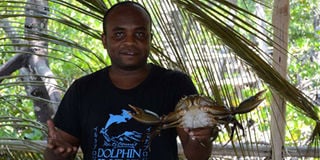From farm to table: Crabs offer rich harvest for group

Dabaso Creek Conservation Group member, Kahindi Charo, holds a mud crab at their Crab Shack Restaurant in Dabaso, Kilifi County. The group fattens crabs in floating cages as a source of income and serve crab meat and samosas at their restaurant which is popular to both local and international tourists. PHOTO | MATHIAS RINGA | NATION MEDIA GROUP
What you need to know:
- Floating cages are good for fattening sea creatures like crabs.
- The 30-member group farms the crabs at a mangrove swamp, harvests and sells at their restaurant.
- They have built 30 floating cages from bamboo, which hold up to 10 crabs each and use them for fattening the sea creatures.
- The crab eatery is popular with tourists from Italy, the UK, Germany, France and Japan.
A cool breeze from the Indian Ocean slaps their faces as they quietly munch their meals under the canopy of giant mangroves.
The Italian tourists were at the Crab Shack Restaurant located on Mida Creek in Kilifi County, specifically to feast on crabs, which are fished from a farm at a mangrove swamp.
The mud crabs, scientifically known as Scylla serrate, are among crustaceans of commercial value along the Kenyan coast.
They are not ordinary food as a meal containing 500g of the delicacy goes for Sh1,500 at the restaurant run by Dabaso Creek Conservation Group.
The 30-member group farms the crabs at a mangrove swamp, harvests and sells at their restaurant.
Kahindi Charo, a member, says they started in 2004 by conserving mangrove forest at Dabaso before getting authorisation from Kenya Forest Service to carry out crab farming.
“Following massive destruction of mangrove forests by pole dealers, we decided to establish a conservation group to combat the menace,” he says, adding the idea of crab farming came later.
They have built 30 floating cages from bamboo, which hold up to 10 crabs each and use them for fattening the sea creatures.
They buy crabs with a minimum weight of 250g from fishermen at between Sh250 and Sh300 depending on the tourist season and fatten them in the cages.

Tourists enjoy crab delicacies at the group's restaurant, Crab Shack, in Kilifi. They harvest between 10 and 30 crabs each week. PHOTO | MATHIAS RINGA | NATION MEDIA GROUP
They feed the crabs twice per day with fish remains until they reach the desired weight of 500g. “The fattening process takes over a month. We harvest the crabs when they are between 450g and 500g and sell at the restaurant where they are prepared by a member of the group who is a chef,” says Charo, noting they started the project with Sh5 million help from Kenya Coastal Development Project (KCDP), a government initiative, and Sh1.8 million from Community Development Trust Fund.
FLOATING CAGES ARE GOOD
They harvest between 10 and 30 crabs each week, but it all depends on the number of guests they receive at the restaurant.
Besides constructing the floating cages, the other cash went to the building of a 200-metre board walks, three restaurants with sitting capacity of between 20 and 90 people, a kitchen and a conference room among other necessities.
Apart from the crab meat, they also serve prawns and other kinds of seafood that they from fishermen. “Hotels in Watamu support us by allowing their guests to visit and eat crab meat at our restaurant.
Holidaymakers from Nairobi, Kilifi, Mombasa and Malindi also visit our restaurant for our mouth-watering crabs,” he says, adding they make up to Sh80,000 in profit every month.
The crab eatery is popular with tourists from Italy, the UK, Germany, France and Japan.
Kenya Marine and Fisheries Research Institute assistant director in-charge of mariculture, Dr James Mwaluma, says crab survival is 80 per cent in floating cages.
“Floating cages are good for fattening the sea creatures as opposed to bottom cages,” he says, noting that for sustainable crab farming, one must have a hatchery.
However, establishing a hatchery is an expensive undertaking as it costs between Sh50 million and Sh100 million.
“The hatcheries can be used for producing crabs, prawns and ornamental fish for sustainable farming.”




